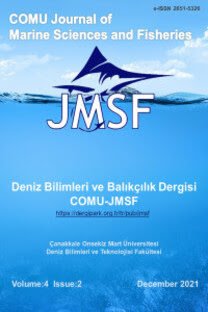Antropojenik Etkilerin Detritus Ayrışım Süreci ve Bir Akarsu Organizması Olan Melanopsis buccinoidea Örneğinde İmzası
Makroomurgasız, Kararlı İzotoplar, Antropojenik Etki, Akuatik ekoloji
Signature of Anthropogenic Impacts in Detritus Decomposition and the Freshwater Snail Melanopsis buccinoidea
Macroinvertebrate, stable isotopes, anthropogenic impact, Aquatic ecology,
___
- Adams, T. S., & Sterner, R. W. (2000). The effect of dietary nitrogen content on trophic level 15 N enrichment, 45(3), 601–607.
- Cloern, J., Canuel, E., & Harris, D. (2002). Stable carbon and nitrogen isotope composition of aquatic and terrestrial plants of the San Francisco Bay estuarine system. Limnology And Oceanography, 47(3), 713–729. https://doi.org/10.4319/lo.2002.47.3.0713
- Coat, S., Monti, D., Bouchon, C., & Lepoint, G. (2009). Trophic relationships in a tropical stream food web assessed by stable isotope analysis. Freshwater Biology, 54(5), 1028–1041. https://doi.org/10.1111/j.1365-2427.2008.02149.x
- Coat, S., Monti, D., Legendre, P., Bouchon, C., Massat, F., & Lepoint, G. (2011). Organochlorine pollution in tropical rivers (Guadeloupe): Role of ecological factors in food web bioaccumulation. Environmental Pollution, 159(6), 1692–1701. https://doi.org/10.1016/j.envpol.2011.02.036
- Cummins, K. W. (1973). Trophic relations of aquatic insects. Annual Review of Entomology, 18(1), 183–206. https://doi.org/10.1146/annurev.en.18.010173.001151
- Cummins, K. W., & Klug, M. J. (1979). Feeding Ecology of Stream Invertebrates. Annual Reviews Ecology and Systematics, 10, 147–172. https://doi.org/10.1146/132359
- Farahnak, A., Vafaie-Darian, R., Mobedi, I., Farahnak A, R Vafaie-Darian, & I Mobedi. (2006). A Faunistic Survey of Cercariae from Fresh Water Snails: Melanopsis spp. and their Role in Transmission Diseases. Iranian Journal of Public Health, 35(4), 70–74. Retrieved from http://ijph.tums.ac.ir/index.php/IJPH/article/view/1798
- Fellerhoff, C. (2002). Feeding and growth of apple snail Pomacea lineata in the Pantanal wetland, Brazil - A stable isotope approach. Isotopes in Environmental and Health Studies, 38(4), 227–243. https://doi.org/10.1080/10256010208033268
- Fourqurean, J. W., & Schrlau, J. E. (2003). Changes in nutrient content and stable isotope ratios of C and N during decomposition of seagrasses and mangrove leaves along a nutrient availability gradient in Florida Bay, USA. Chemistry and Ecology, 19(5), 373–390. https://doi.org/10.1080/02757540310001609370
- Fry, B. (2006). Stable Isotope Ecology. Libro (Vol. XII). https://doi.org/10.1007/0-387-33745-8
- Guo, L., Qiu, Y., Zhang, G., Zheng, G. J., Lam, P. K. S., & Li, X. (2008). Levels and bioaccumulation of organochlorine pesticides (OCPs) and polybrominated diphenyl ethers (PBDEs) in fishes from the Pearl River estuary and Daya Bay, South China. Environmental Pollution, 152(3), 604–611. https://doi.org/10.1016/j.envpol.2007.06.067
- Heller, J., & Abotbol, A. (1997). Litter shredding in a desert oasis by the snail Melanopsis praemorsa . Hydrobiologia, 344(1991), 65–73. https://doi.org/10.1023/A:1002998126349
- Hilderbrand, G., Farley, S., Robbins, C., Hanley, T., Titus, K., & Servheen, C. (1998). Use of stable isotopes to determine diets of living and extinct bears. Canadian Journal of Zoology, 74, 2080–2088. https://doi.org/10.1139/z98-165
- Jonsson, M., & Malmqvist, B. (2000). Ecosystem process rate increases with animal species richness: Evidence from leaf-eating, aquatic insects. Oikos, 89(3), 519–523. https://doi.org/10.1034/j.1600-0706.2000.890311.x
- Kiriluk, R. M., Servos, M. R., Whittle, D. M., Cabana, G., & Rasmussen, J. B. (1995). Using ratios of stable nitrogen and carbon isotopes to characterize the biomagnification of DDE, mirex, and PCB in a Lake Ontario pelagic food web. Canadian Journal of Fisheries and Aquatic Sciences, 52, 2660–2674. https://doi.org/10.1139/f95-855
- Lin, G. H., & Ehleringer, J. R. (1997). Carbon isotopic fractionation does not occur during dark respiration in C-3 and C-4. Plant Physiology, 114(1), 391–394.
- Masese, F. O., Kitaka, N., Kipkemboi, J., Gettel, G. M., Irvine, K., & Mcclain, M. E. (2014). Litter processing and shredder distribution as indicators of riparian and catchment influences on ecological health of tropical streams. Ecological Indicators, 46, 23–37. https://doi.org/10.1016/j.ecolind.2014.05.032
- McClelland, J. W., Valiela, I., & Michener, R. H. (1997). Nitrogen-stable isotope signatures in estuarine food webs: A record of increasing urbanization in coastal watersheds. Limnology and Oceanography, 42(5), 930–937. https://doi.org/10.4319/lo.1997.42.5.0930
- Melillo, J., Aber, J., Linkins, A., Ricca, A., Fry, B., & Nadelhoffer, K. (1998). Carbon and nitrogen dynamics along the decay continuum: plant litter to soil organic matter. Plant and Soil, 115, 189–198. Retrieved from https://link.springer.com/article/10.1007/BF02202587
- Nishida, M., & Sato, Y. (2015). Characteristics of the Relationship between Natural 15 N Abundances in Organic Rice and Soil. Plant Production Science, 18(2), 180–186. https://doi.org/10.1626/pps.18.180
- Peterson, B. J. (1999). Stable isotopes as tracers of organic matter input and transfer in benthic food webs: A review (TEACHING FILES). Acta Oecologica, 20(4), 479–487.
- Schweizer, M., Fear, J., & Cadisch, G. (1999). Isotopic (13C) fractionation during plant residue decomposition and its implications for soil organic matter studies. Rapid Communications in Mass Spectrometry, 13(13), 1284–1290. https://doi.org/10.1002/(SICI)1097-0231(19990715)13:13<1284::AID-RCM578>3.0.CO;2-0
- Sokal, R. R., & Rohlf, F. (1995). Biometry: the principles and practice of statistics in biological research, (April 2013).
- Vannote, R. L., Minshall, G. W., Cummins, K. W., Sedell, J. R., & Cushing, C. E. (1980). The River Continuum Concept. Canadian Journal of Fisheries and Aquatic Sciences, 37, 130–137.
- Yayın Aralığı: 2
- Başlangıç: 2018
- Yayıncı: Çanakkale Onsekiz Mart Üniversitesi Deniz Bilimleri ve Teknolojisi Fakültesi
Serpil ODABAŞI, Semra CİRİK, Naime ARSLAN
Büyükeceli Sahilindeki (Kuzey-Doğu Akdeniz) Centrolophus niger (Gmelin, 1789)’in Yeni Lokalite Kaydı
Deniz ERGÜDEN, Deniz AYAS, Nuray ÇİFTÇİ, Mısra BAKAN
İldeniz PINAR, Sukran YALÇIN OZDİLEK
Akyatan Lagünü (Karataş, Adana) Diyatom ve Dinoflagellat Topluluklarının Zamansal Değişimi
İbrahim Ender KÜNİLİ, Fatma Arık ÇOLAKOĞLU
Titanyum Dioksit ve Nano Titanyum Dioksit Kullanımının Su Ürünlerine Olası Zararları
